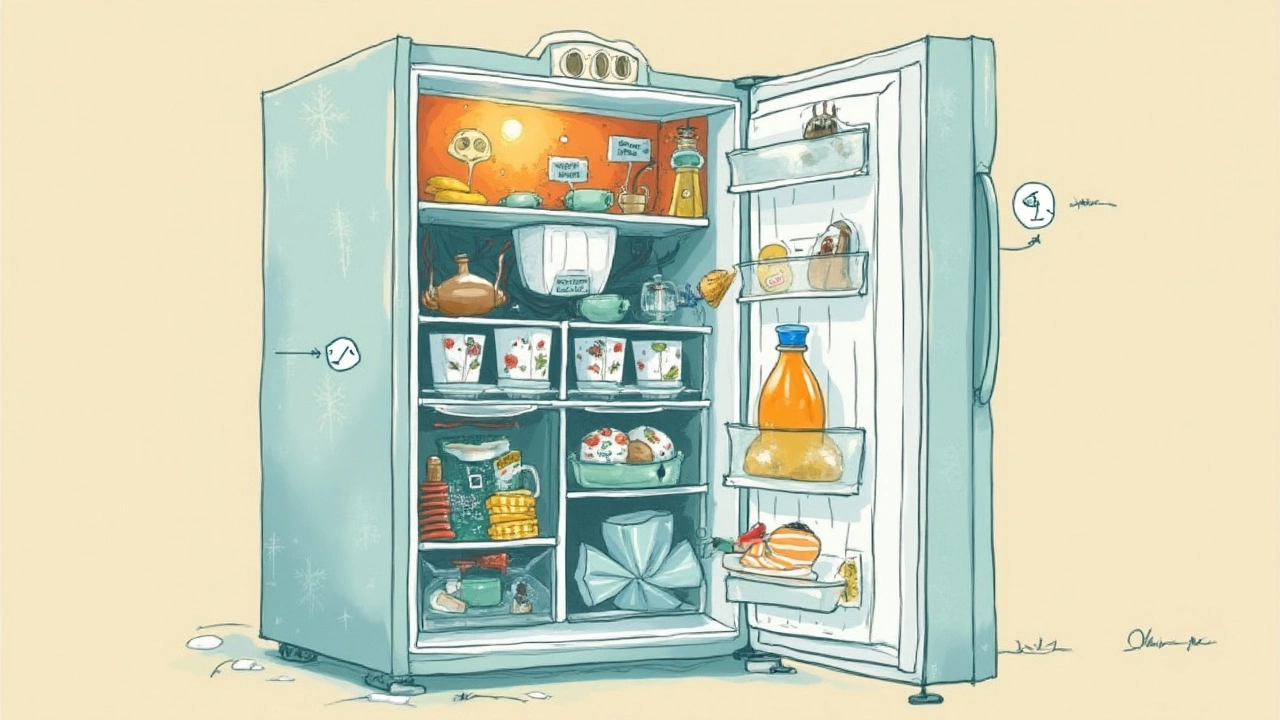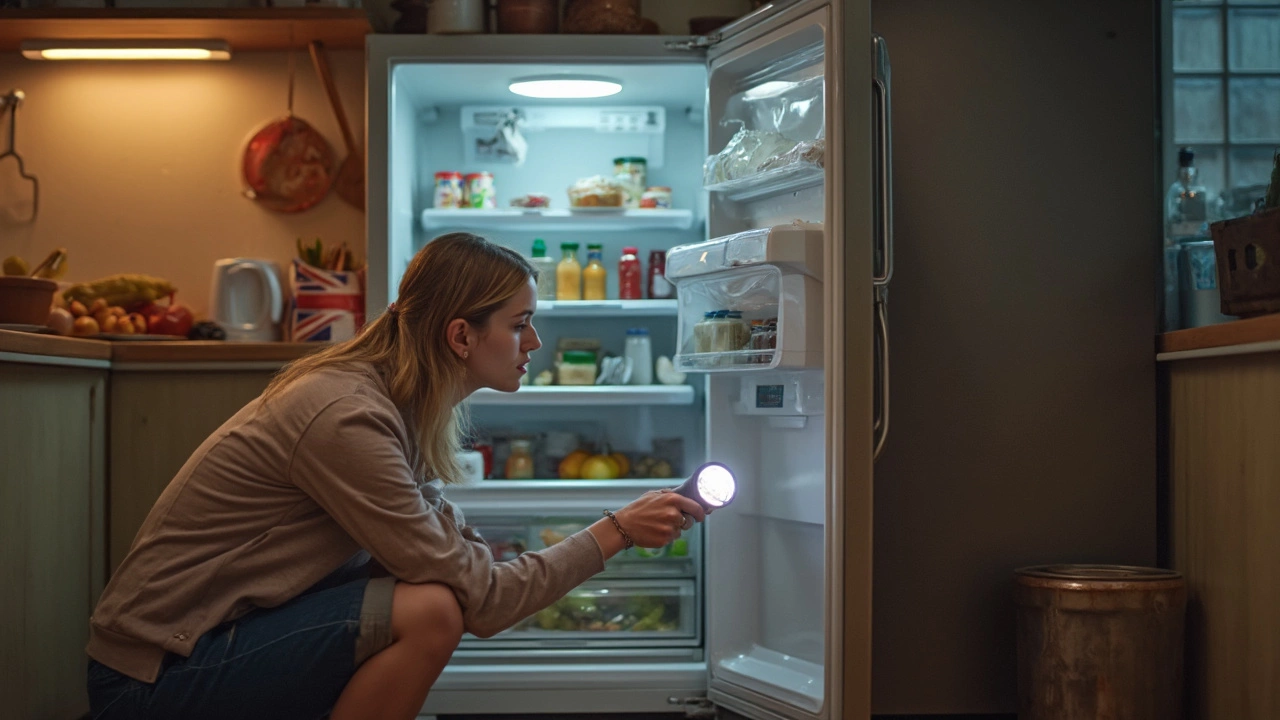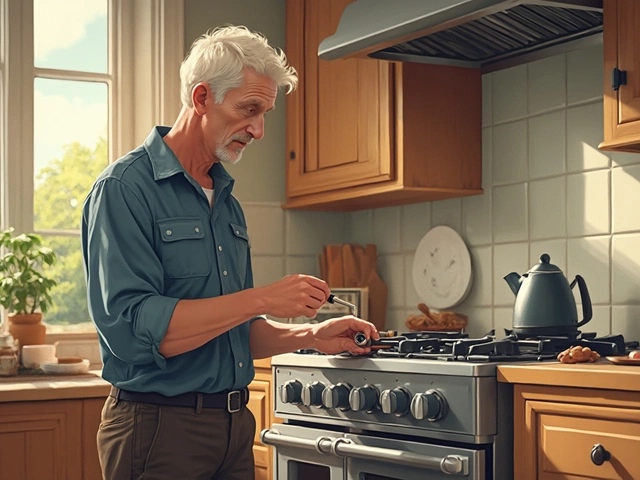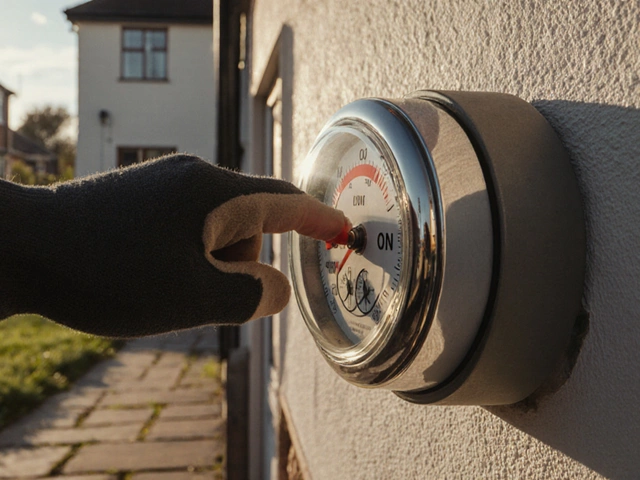You're grabbing some ice cream—and bam, everything in your freezer is soggy and warm. Why on earth did your freezer just stop working? It's not always a big, dramatic failure. Sometimes, it's a dead-simple problem you can spot in a minute.
Start with the basics: is it even getting power? A loose plug, tripped breaker, or a bad outlet can all wipe out your freezer's chill before you know it. You'd be surprised how often people call for repairs only to find the freezer just got unplugged when someone cleaned behind it.
If that's not it, don't panic. Your freezer's got a few moving parts, and most issues come down to just a handful of common glitches. We'll break down the big ones, show you what you can check yourself, and flag the stuff where you might actually need a pro. Let's get your food cold again—fast.
- Power Problems: The Usual Suspects
- Thermostat and Temperature Troubles
- Frost Buildup and Airflow Blockers
- Compressor and Mechanical Fails
- Quick DIY Fixes and When to Call for Help
Power Problems: The Usual Suspects
It sounds almost too simple, but the most common reason a freezer repair is needed is because of power issues. Before you assume your freezer’s finally bit the dust, it’s worth checking a few things right at the source. You’d be amazed at how often folks overlook the basics and end up tossing out perfectly good food for no reason.
Start at the wall. Is the plug fully in the outlet? Maybe it got bumped when someone vacuumed or moved the fridge around to clean. Sometimes, the outlet itself is the culprit. A quick trick: plug in a lamp or phone charger. If that doesn't work, your outlet might be dead, and the freezer never had a chance.
Next up: circuit breakers. Freezers pull a decent amount of power, and it's pretty common for a breaker to trip if something else on that circuit pulls too much juice. Head to your breaker box and look for any switches out of place. If you flip it back and it trips again, that’s a sign there might be a bigger electrical issue.
Extension cords are another sneaky problem. They can wear out or just not deliver enough consistent power, especially older ones or cords with too many things plugged into them. Freezers really are meant to plug straight into the wall. Using an extension cord or a power strip increases the risk of voltage drops, which can shut things down in a hurry.
A little less obvious? GFCI outlets—those protective ones with a “reset” button—can trip if there’s any hint of a power leak. If you see this style outlet behind your freezer, try pressing “reset” and see if you’re back in business. Sometimes that’s all it takes.
If all this checks out and you still hear nothing, it's probably time to grab a multimeter and see if any power is getting to the back of the freezer at all. There's always a fuse or two inside your appliance, and those blow out just often enough to be worth checking. If testing fuses or electrical parts feels risky, time to call in someone with more experience. No cold food is worth a shocking experience.
Thermostat and Temperature Troubles
The thermostat is the boss of your freezer’s coldness. If it’s wonky or broken, your frozen pizzas start to thaw pretty fast. Freezers are meant to keep food below 0°F (-18°C)—but when the thermostat drifts out of range or quits, you’re in trouble. A recent survey found that about 15% of all freezer repair calls come down to issues with the thermostat or the temperature control dial.
So how do you know if the thermostat is the bad guy? Check if the internal light still works and the compressor runs at all. If your freezer feels warm, spin the temperature dial down to the coldest setting. Listen for a click—no sound probably means the thermostat is broken, especially if other parts have power.
- Try unplugging and plugging the freezer back in, then adjust the thermostat again. Sometimes contacts inside get stuck and resetting fixes it.
- Use a basic fridge/freezer thermometer to check how cold it actually is. Don’t rely on guessing by touch.
- If your freezer is still under warranty, messing with the thermostat too much can void coverage. Always check first if you plan to do any part swaps.
If you want to peek under the hood, some thermostats are pretty easy to spot. There’s usually a dial with a copper wire or sensor running towards the back or side. Dust and grime can actually mess with its reading, so wipe it down gently.
Here’s what you’re aiming for:
| Freezer Setting | Target Temperature (°F) | Likely Results |
|---|---|---|
| Lowest/coldest | -5 to 0 | Meat stays solid, ice cream hard |
| Medium | +5 to 0 | Fine for most foods |
| Warm/highest | Above +5 | Food gets mushy, ice melts |
If temperatures are off even when you adjust the dial, the thermostat may need to be replaced. You can find universal thermostats online for $15–$55, but make sure they're the right fit and can handle your freezer’s specs.

Frost Buildup and Airflow Blockers
If your freezer looks like an arctic cave, that thick frost isn’t just ugly—it’s messing with how your freezer works. Air needs to flow over the coils and around your food to keep things frozen. Too much frost, and it can’t. That’s one of the top reasons for a freezer stopped working situation, even if the motor’s humming along.
Frost usually builds up because the door didn’t seal right, or you opened it a lot in a humid room. All that warm, moist air sneaks in, freezes, and just keeps piling up. In some frost-free freezers, a broken defrost timer or heater can cause serious ice walls too.
Here’s how airflow issues usually pop up:
- Vents inside your freezer get blocked by packed-in food.
- Fans stop spinning due to frost or broken motors.
- Coils get buried in ice, trapping cold air and making the freezer less effective.
Some freezers literally shut down if the airflow gets too blocked. That means the fix can be as simple as thawing things out and rearranging your food. If it keeps happening though, you probably have a deeper issue with the defrost system.
If you’re curious or want to compare, here’s a quick table showing normal frost versus the levels that spell trouble:
| Frost Buildup | What It Means | What To Do |
|---|---|---|
| Thin, powdery layer | Normal use | Just monitor it |
| Patches thicker than 1/4 inch | Poor sealing, frequent door use, or defrost fail | Check door seals, defrost if needed |
| Solid ice sheets or blocks | Defrost system failed or major airflow block | Full manual defrost and call for repair if it returns fast |
The main takeaway: don’t let frost and blocked vents turn your freezer into a warm box. A little maintenance—like not cramming it full and wiping seal gaskets—can save your groceries and your sanity.
Compressor and Mechanical Fails
Ever hear your freezer make a weird humming, click, or total silence after it’s been running fine? That’s usually a sign the compressor or a related part kicked the bucket. The compressor is the freezer’s heart. If it’s dead, cold air is out of the question, no matter what settings you change.
The most obvious sign of compressor failure is a freezer that’s running but not freezing. Sometimes, the compressor overheats and shuts off; other times, it just won’t start at all. A failing compressor might make clicking noises every few minutes—it’s trying but can’t quite fire up.
Besides the compressor itself, other tiny but mighty parts can quit and mess up your freezer:
- Start relay: Helps the compressor kick on, but it wears out faster than the compressor. If it’s dead, the compressor stays off.
- Capacitor: Gives the compressor the juice it needs to start. Bad capacitor = no cold.
- Evaporator fan motor: Circulates cold air. If it goes, the freezer gets warm or uneven chilly spots.
- Condenser fan motor: Keeps the compressor cool. If it’s busted, the compressor can overheat and shut down.
Here's a quick-reference table with symptoms and which mechanical part might be involved:
| Problem | Likely Culprit | What You Notice |
|---|---|---|
| Freezer warm, runs nonstop | Compressor or relay | Compressor always humming or clicking, food melts |
| No noise at all, freezer dead | Start relay or compressor | Silence, no vibration, no cooling |
| Freezer cold in some spots but not others | Evaporator fan | Uneven freezing, frost in strange places |
| Strange burning smell or hot back panel | Condenser fan | Back of freezer very hot |
Unless you’re handy with appliances, messing with compressors is risky. They’re sealed systems, and fixing them usually needs special tools and experience. Truth is, if your compressor or sealed system died and your freezer’s out of warranty, most folks are better off with a new unit—it’s usually not worth the huge repair bill. But if a pro says it’s just the start relay or a fan, those fixes aren’t too brutal.
Quick tip: If your freezer repair involves any part labeled “sealed system,” that’s your clue this will be pricier or trickier than a basic fix.

Quick DIY Fixes and When to Call for Help
If your freezer's lost its chill, you don't have to be a pro to try a few quick fixes. Here are things you can do right now to see if you can avoid a repair bill.
- Check the plug and outlet: Make sure the freezer is plugged in tight. Try plugging in a lamp or phone charger to see if the outlet works. If nothing works, there might be a blown fuse or a tripped breaker—flip your breakers and check again.
- Dial the thermostat: Sometimes the dial gets bumped or iced over. Turn it up or down, wait a few minutes, and listen for the motor kicking in.
- Clear out vents and space: Food pressed against freezer vents can block cold air flow. Move stuff away from the vents and keep things a little spaced out inside. Also, make sure there are a few inches between the back of your freezer and the wall.
- Look for ice buildup: A thick layer of frost or ice can stop things from working right. If you see more than a quarter inch, unplug and defrost the freezer. This can take several hours but often brings things back to normal.
- Clean dusty coils: Dirty condenser coils work overtime, making the freezer run hotter and sometimes shut down. Use a vacuum or soft brush to clean them if you can reach them safely (usually below or behind the unit).
Sometimes, though, it’s not a DIY fix. Call a professional if:
- You hear clicking, buzzing, or nothing at all from the compressor even after power resets.
- The inside light works, but nothing else runs.
- There’s water leaking from under the unit that's not just defrost runoff.
- You find burning smells or melted wires anywhere near the plug or inside the freezer.
Freezer repairs aren’t always cheap. Here’s a rough idea of what you might pay if it’s more than just a quick fix:
| Type of Repair | Estimated Cost (USD) |
|---|---|
| Thermostat replacement | $100 - $250 |
| Compressor repair | $200 - $500 |
| New start relay | $60 - $200 |
| Defrost timer | $120 - $250 |
Don’t wait when your food’s at risk. If basic checks don’t work, get help quickly before things spoil. Sometimes a fast call saves you way more than it costs, especially when your freezer is full.




